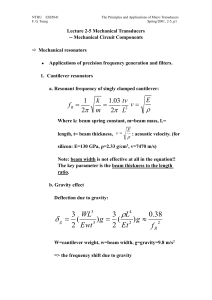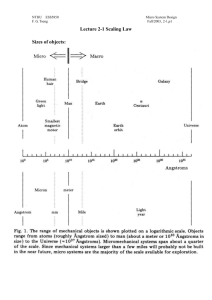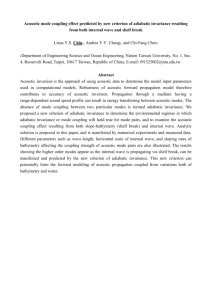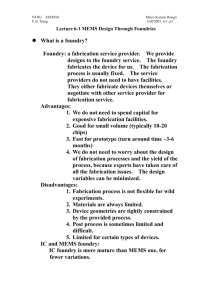Lecture 5-2 Chemical and Biological Transducers II –
advertisement
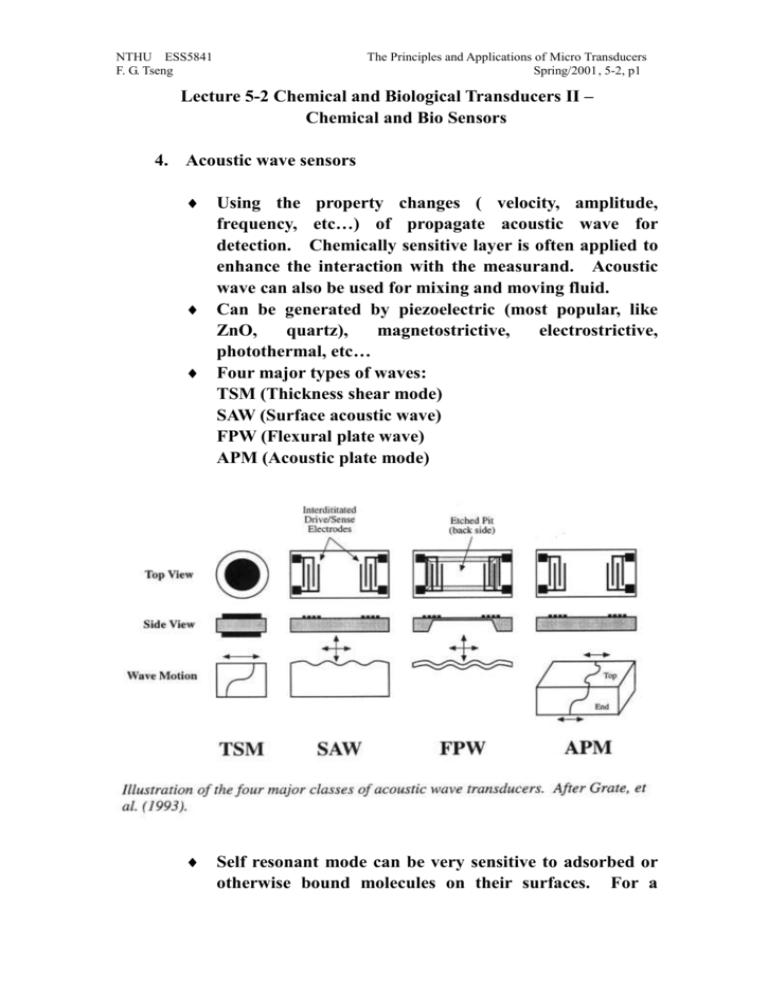
NTHU ESS5841 F. G. Tseng The Principles and Applications of Micro Transducers Spring/2001, 5-2, p1 Lecture 5-2 Chemical and Biological Transducers II – Chemical and Bio Sensors 4. Acoustic wave sensors Using the property changes ( velocity, amplitude, frequency, etc…) of propagate acoustic wave for detection. Chemically sensitive layer is often applied to enhance the interaction with the measurand. Acoustic wave can also be used for mixing and moving fluid. Can be generated by piezoelectric (most popular, like ZnO, quartz), magnetostrictive, electrostrictive, photothermal, etc… Four major types of waves: TSM (Thickness shear mode) SAW (Surface acoustic wave) FPW (Flexural plate wave) APM (Acoustic plate mode) Self resonant mode can be very sensitive to adsorbed or otherwise bound molecules on their surfaces. For a NTHU ESS5841 F. G. Tseng The Principles and Applications of Micro Transducers Spring/2001, 5-2, p2 SAW device, Sauerbrey equation for frequency shift: f kf02 m A k: device dependent constant, f0: natural resonant frequency without loading. m: mass change. A: area of membrane. Can be used to viscoelastic sensing, acoustoelectric sensing, liquid density, and viscosity. a. Viscoelastic sensing: changes in resonant frequency due to polymer mechanical modulus effects (like swelling). This can be used to sense vapor. b. Acoustoelectric sensing: The bound charges generated by acoustic wave have a electric field to cause motion of charge carries and dipoles in the adjacent medium, thus affect the wave’s velocity and attenuation (frequency does not change) c. Liquid density and viscosity can affect wave frequency and quality factor, respectively. 5. Biosensors Biological molecules are used to perform an intermediate transduction between the desired measurand through selectivity of bio-molecule interactions. Enzyme (protein), antibody (protein), polysaccharide, or nucleic acid are used. The sensing devices can be those discussed in the chemical sensor section, including ISFET, microelectrodes, microcalorimeter, acoustic wave device, etc… NTHU ESS5841 F. G. Tseng The Principles and Applications of Micro Transducers Spring/2001, 5-2, p3 Four possible modes of physically coupling the biomolecules to the basic sensor i. membrane entrapment ( case specific) ii. physical adsorption (gentle binding, less distortion of the conformation of molecules, but easily effected by pH, temperature) iii. matrix entrapment (similar to membrane type) iv. covalent bonding (most permanent bonding, but may chemically modify the binding sites and denature the molecules) NTHU ESS5841 F. G. Tseng The Principles and Applications of Micro Transducers Spring/2001, 5-2, p4 the biological material used need to consider the following: i. material is constrained for the life time of bio-sensors ii. contact with analyte solution iii. by-products can be diffused away iv. biomaterials are not inactivated by the immobilization layer. a. Resonant Biosensors Acoustic wave or other resonant sensors can be used as biosensors. A sensitivity molecule is attached to the surface of the resonator and the binding of the analyte molecules adds mass causing frequency shift. b. Optical-detection biosensors Optical diffraction: antibody-antigen binding area shows diffraction grating. Using latex or colloidal gold to increase the effective size of the bound analyte to amplify signal. Electrochemiluminescence (ECL):when electrical current is passed through an appropriate mixture of compounds, light is emitted at an amplitude related to the concentration of a iluminescence cell for the detection of fluorescently labeled samples Fiber optical biosensors. c. Thermal-detection biosensors Calorimeters: The heat of reaction for each enzyme can be measured and is related to its concentration. d. ISFET biosensors (CHEMFETs) NTHU ESS5841 F. G. Tseng The Principles and Applications of Micro Transducers Spring/2001, 5-2, p5 e. Electrochemical –detection biosensors Cyclic voltammetry has been used to detect DNA hybridization and DNA-binding drugs. The anodic peak current is a linear relationship with the concentration of the samples. Amperometric biosensor: glucose sensor as an example: Using polyvinyl alcohol (PVA) matrix to apply the enzyme glucose oxidase (GOD) to a Pt electrode. Thick-film Ag/AgCl counterelectrode for reference. Pt held at 700mV and oxidize hydrogen peroxide to release current. glu cos e O2 gluconolac tone H 2O2 H 2O2 O2 2 H 2e _ The glucose concentration can be determined by the current or pH. f. CMOS-compatible biosensor Screen printing: screened printed polymer membrane NTHU ESS5841 F. G. Tseng The Principles and Applications of Micro Transducers Spring/2001, 5-2, p6 containing bio-molecules on CMOS wafer. Screen printed silver epoxy is also applied for the interconnection. g. Others Using whole cell as part of sensors SPR (Surface Plasma Resonance)
